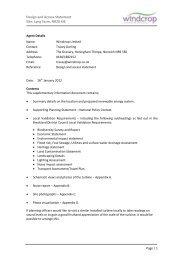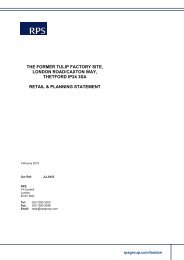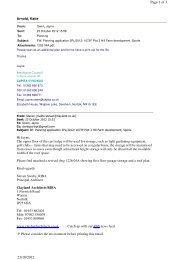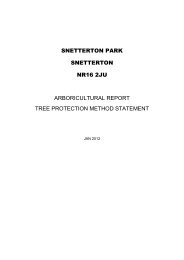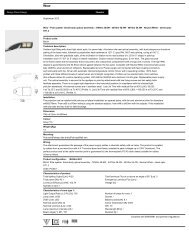flood risk assessment in connection with a planning - Breckland ...
flood risk assessment in connection with a planning - Breckland ...
flood risk assessment in connection with a planning - Breckland ...
Create successful ePaper yourself
Turn your PDF publications into a flip-book with our unique Google optimized e-Paper software.
Flood Risk Assessment Tesco Supermarket, Swaffham<br />
2.7 Soils<br />
Accord<strong>in</strong>g to the Wall<strong>in</strong>gford Procedure W<strong>in</strong>ter Ra<strong>in</strong>fall Acceptance<br />
Potential (WRAP) map, the site has a low acceptance potential (WRAP<br />
Class 4), <strong>with</strong> an associated „SOIL‟ classification of 0.3. This SOIL<br />
parameter <strong>in</strong>dicates that, on an annual basis, approximately 30% of<br />
ra<strong>in</strong>fall does not <strong>in</strong>filtrate <strong>in</strong>to the underly<strong>in</strong>g ground and runoff as<br />
surface water.<br />
The standard percentage runoff derived us<strong>in</strong>g the hydrology of soils<br />
types (SPRHOST) provides a measure of the volumetric characteristic<br />
of the runoff response to ra<strong>in</strong>fall. SPRHOST was obta<strong>in</strong>ed for the site<br />
from the Flood Estimation Handbook (FEH) CD-ROM for the<br />
catchment. The catchment was selected as it covers a small area<br />
approximately 1.19km 2 . An SPRHOST value of 11.19 was obta<strong>in</strong>ed,<br />
<strong>in</strong>dicat<strong>in</strong>g that approximately 11% of ra<strong>in</strong>fall runoff as surface water <strong>in</strong><br />
this catchment, An SPRHOST value of 11% corresponds <strong>with</strong> a SOIL<br />
value of 0.45. This is the value for the whole catchment.<br />
As discussed above the soil survey identifies the site to be underla<strong>in</strong><br />
wholly by the Denbigh 1 – 541j soil type.<br />
Us<strong>in</strong>g the FEH volume 4, a specific <strong>assessment</strong> of the SPR for the site<br />
can be calculated from the 29 <strong>in</strong>dex soil classes us<strong>in</strong>g the percentages<br />
which make up the Denbigh 1 – 541j soil type. The SPR is estimated<br />
from HOST soil class fractions, the table below show<strong>in</strong>g how the soil<br />
beneath the site is divided up and pro-rata‟d to give a site specific SPR.<br />
Soil Type HOST HOST Class SPR value for Totals<br />
Classes Percentage HOST Class<br />
Denbigh 1 – 541j Class 1 50.00% 2% 1.0%<br />
Class 5 30% 14.50% 4.35%<br />
Class 16 20.00% 29.20% 5.84%<br />
TOTAL<br />
Site SPR =<br />
11.19%<br />
An SPR value of 11% corresponds <strong>with</strong> a SOIL value of 0.11. This is<br />
the value for the site only. There is a significant difference <strong>in</strong> the WRAP<br />
soil parameter, the SPRHOST and the SPR for the site. As the<br />
SPRHOST and SPR values are derived us<strong>in</strong>g 29 soil classes as<br />
opposed to the five def<strong>in</strong>ed on the WRAP map, it is generally<br />
considered that SPR values provide a more accurate representation of<br />
soil characteristics and variation <strong>in</strong> runoff between soil types. The most<br />
conservative value, SPR, has therefore been adopted <strong>in</strong> the estimation<br />
of greenfield runoff rates from the proposed site.<br />
Page 5<br />
Jubb Consult<strong>in</strong>g Eng<strong>in</strong>eers Limited February 2012<br />
P9632-G300C-Rep-120209-MH





